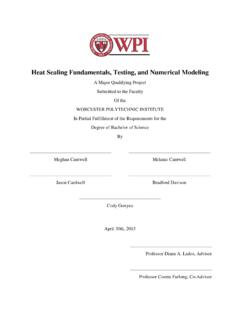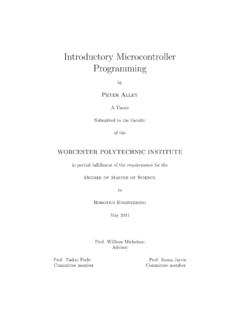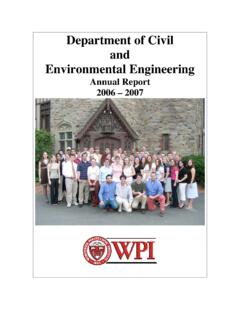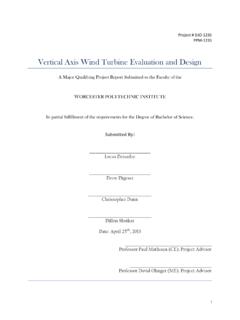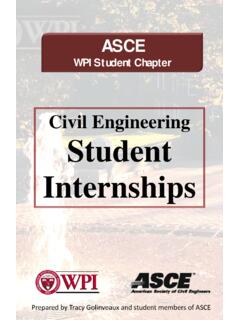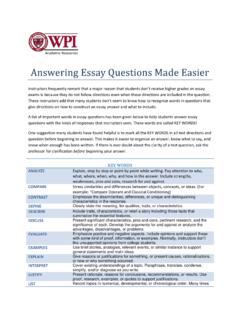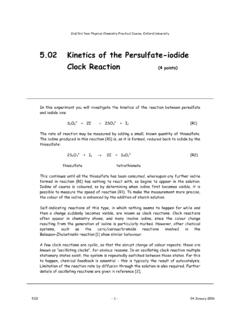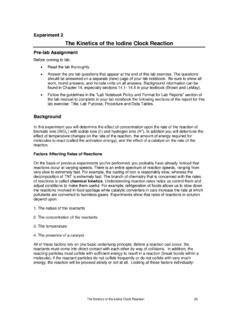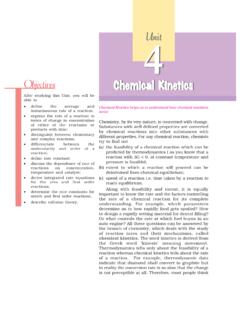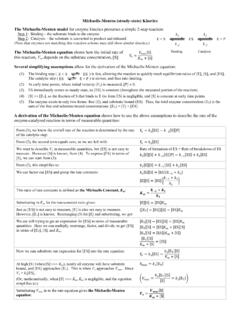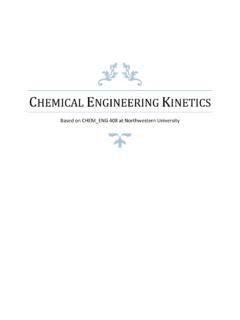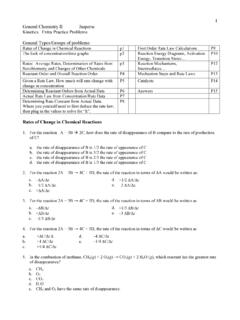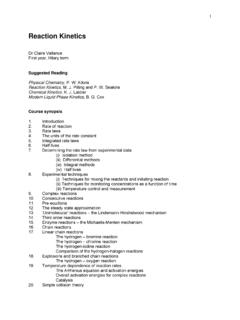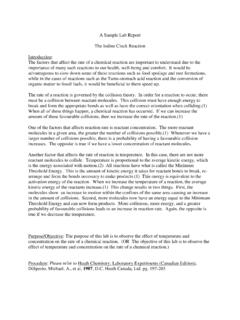Transcription of Kinetics and Catalysis of the Water-Gas-Shift Reaction: A ...
1 Kinetics and Catalysis of the Water-Gas-Shift Reaction: A Microkinetic and Graph Theoretic Approach A Dissertation Submitted to the Faculty of the WORCESTER POLYTECHNIC INSTITUTE Department of Chemical Engineering In partial fulfillment of the requirements for the Degree of Doctor of Philosophy in Chemical Engineering by _____ Caitlin A. Callaghan March 31, 2006 _____ Professor Ravindra Datta, Advisor WPI Chemical Engineering Department _____ Professor Ilie Fishtik, Co-Advisor WPI Chemical Engineering Department _____ Professor Nikolaos K. Kazantzis WPI Chemical Engineering Department _____ Professor Joseph D. Fehribach WPI Mathematical Sciences & Chemical Engineering Department _____ Professor Jennifer L. Wilcox WPI Chemical Engineering Department _____ Dr. A. Alan Burke Naval Undersea Warfare Center, Newport, RI _____ Professor David DiBiasio, Dept. Head WPI Chemical Engineering Department Kinetics and Catalysis of the Water-Gas-Shift Reaction: A Microkinetic and Graph Theoretic Approach i ABSTRACT The search for environmentally benign energy sources is becoming increasingly urgent.
2 One such technology is fuel cells, , the polymer electrolyte membrane (PEM) fuel cell which uses hydrogen as a fuel and emits only H2O. However, reforming hydrocarbon fuels to produce the needed hydrogen yields reformate streams containing CO2 as well as CO, which is toxic to the PEM fuel cell at concentrations above 100ppm. As the amount of CO permitted to reach the fuel cell increases, the performance of the PEM fuel cell decreases until it ultimately stops functioning. The Water-Gas-Shift (WGS) reaction, CO + H2O ' H2 + CO2, provides a method for extracting the energy from the toxic CO by converting it into usable H2 along with CO2 which can be tolerated by the fuel cell. Although a well established industrial process, alternate catalysts are sought for fuel cell application. Catalyst selection for the WGS reaction has, until recently, been based on trial-and-error screening of potential catalysts due to a lack of fundamental understanding of the catalyst s functioning.
3 For this reason, we embarked on a deeper understanding of the molecular events involved in the WGS reaction such that a more systematic and theory-guided approach may be used to design and select catalysts more efficiently, , rational catalyst design. The goal of this research was to develop a comprehensive predictive microkinetic model for the WGS reaction which is based solely on a detailed mechanism as well as theories of surface-molecule interactions ( , the transition-state theory) with energetic parameters determined a priori. This was followed by a comparison of the experimental results of sample catalysts to validate the model for various metal-based catalysts of interest including Cu, Fe, Ni, Pd, Pt, Rh, and Ru. A comprehensive mechanism of the plausible elementary reaction steps was compiled from existing mechanisms in the literature. These were supplemented with other likely candidates which are derivatives of those identified in the literature.
4 Using established theories, we predicted the Kinetics of each of the elementary reaction steps on metal catalysts of interest. The Unity Bond Index-Quadratic Exponential Potential Method (UBI-QEP) was used to predict the activation energies in both the forward and Kinetics and Catalysis of the Water-Gas-Shift Reaction: A Microkinetic and Graph Theoretic Approach ii reverse direction of each step based solely on heats of chemisorption and bond dissociation energies of the species involved. The Transition State Theory (TST) was used to predict the pre-exponential factors for each step assuming an immobile transition state; however, the pre-exponential factors were adjusted slightly to ensure thermodynamic consistency with the overall WGS reaction. In addition, we have developed a new and powerful theoretical tool to gain further insight into the dominant pathways on a catalytic surface as reactants become products.
5 Reaction Route (RR) Graph Theory incorporates fundamental elements of graph theory and electrical network theory to graphically depict and analyze reaction mechanisms. The stoichiometry of a mechanism determines the connectivity of the elementary reaction steps. Each elementary reaction step is viewed as a single branch with an assumed direction corresponding to the assumed forward direction of the elementary reaction step. The steps become interconnected via nodes which reflect the quasi-steady state conditions of the species represented by the node. A complete RR graph intertwines a series of routes by which the reactants may be converted to products. Once constructed, the RR graph may be converted into an electrical network by replacing, in the steady-state case, each elementary reaction step branch with a resistor and including the overall reaction as a power source where rate and affinity correspond to current and voltage, respectively.
6 A simplification and reduction of the mechanism may be performed based on results from a rigorous De Donder affinity analysis as it correlates to Kirchhoff s Voltage Law (KVL), akin to thermodynamic consistency, coupled with quasi-steady state conditions, , conservation of mass, analyzed using Kirchhoff s Current Law (KCL). Hence, given the elementary reaction step resistances, in conjunction with Kirchhoff s Laws, a systematic reduction of the network identifies the dominant routes, , the routes with the lowest resistance, along with slow and quasi-equilibrium elementary reaction steps, yielding a simplified mechanism from which a predictive rate expression may possibly be derived. Here, we have applied RR Graph Theory to the WGS reaction. An 18-step mechanism was employed to understand and predict the Kinetics of the WGS reaction. From the stoichiometric matrix for this mechanism, the topological features necessary to Kinetics and Catalysis of the Water-Gas-Shift Reaction: A Microkinetic and Graph Theoretic Approach iii assemble the RR graph, namely the intermediate nodes, terminal nodes, empty reaction routes and full reaction routes, were enumerated and the graph constructed.
7 The assembly of the RR graph provides a comprehensive overview of the mechanism. After reduction of the network, the simplified mechanism, comprising the dominant pathways, identified the quasi-equilibrium and rate-determining steps, which were used to determine the simplified rate expression which predicts the rate of the complete mechanism for different catalysts. Experimental investigations were conducted on the catalysts of interest to validate the microkinetic model derived. Comparison of the experimental results from the industrially employed catalysts ( , Cu, Ni, Fe, etc.) shows that the simplified microkinetic model sufficiently predicts the behavior of the WGS reaction for this series of catalysts with very good agreement. Other Catalysis tested (Pt, Pd, Rh and Ru), however, had sufficient methanation activity that a direct comparison with WGS Kinetics could not be made.
8 In summary, we have developed a comprehensive approach to unravel the mechanism and Kinetics of a catalytic reaction. The methodology described provides a more fundamental depiction of events on the surface of a catalyst paving the way for rational analysis and catalyst design. Illustrated here with the WGS reaction as an example, we show that the dominant RRs may be systematically determined through the application of rigorous fundamental constraints ( thermodynamic consistency and mass conservation) yielding a corresponding explicit a priori rate expression which illustrates very good agreement not only with the complete microkinetic mechanism, but also the experimental data. Overall, RR graph theory is a powerful new tool that may become invaluable for unraveling the mechanism and Kinetics of complex catalytic reactions via a common-sense approach based on fundamentals.
9 Kinetics and Catalysis of the Water-Gas-Shift Reaction: A Microkinetic and Graph Theoretic Approach iv ACKNOWLEDGEMENTS I would like to thank the following individuals for their assistance, support, guidance and inspiration during the time I have worked on this research. My Advisors: f Prof. Ravindra Datta, Advisor f Prof. Ilie Fishtik, Co-Advisor My Thesis Committee Members: f Prof. Nikolaos K. Kazantzis f Prof. Joseph D. Fehribach f Prof. Jennifer L. Wilcox f Dr. A. Alan Burke My Labmates: f Dr. Nikhil Jalani f Saurabh Vilekar f James Liu f Dr. Pyoungho Choi f Dr. Jingxin Zhang f Dr. Tony Thampan f Katherine Fay The Department Staff: f Sandy Natale f Jack Ferraro f Doug White f Paula Moravek My family and friends, as well as everyone else I ve met along the way. I would like to acknowledge the following sources for funding: f General Motors GM Fellowship Program f Office of Naval Research/University Laboratory Initiative f WPI s Backlin Scholarship Kinetics and Catalysis of the Water-Gas-Shift Reaction: A Microkinetic and Graph Theoretic Approach v The art is finding a model adequate to the problem, and, for the pragmatist, the only criterion of a molecular model is its value to chemists assessed by its performance.
10 -- E. Shustorovich Kinetics and Catalysis of the Water-Gas-Shift Reaction: A Microkinetic and Graph Theoretic Approach vi TABLE OF CONTENTS ABSTRACT i ACKNOWLEDGEMENTS iv TABLE OF CONTENTS vi INDEX OF FIGURES x INDEX OF TABLES xiv INDEX OF TABLES xiv NOMENCLATURE xvi Chapter 1. Introduction 29 Chapter 2. Literature Review of the Water-Gas-Shift Reaction 36 The PEM Fuel Cell Plant 36 The Water-Gas Shift Reaction 40 Water-Gas Shift Catalysts 43 Copper-based Catalysts 43 Iron-based Catalysts 45 Nickel-based Catalysts 48 Gold-based Catalysts 51 Platinum-based Catalysts 52 Ruthenium-based Catalysts 53 Iridium-based Catalysts 54 Water-Gas Shift Mechanism and Kinetics 55 The Formate Mechanism 59 The Redox Mechanism 66 The Carbonate Mechanism 84 Other Mechanisms 87 Adopted Mechanism 94 Chapter 3.
